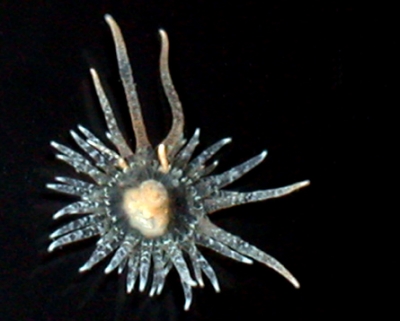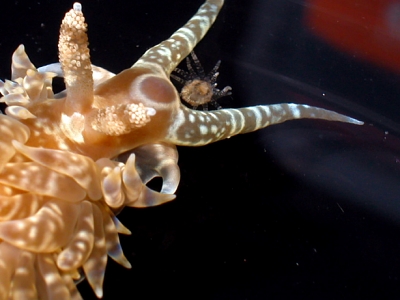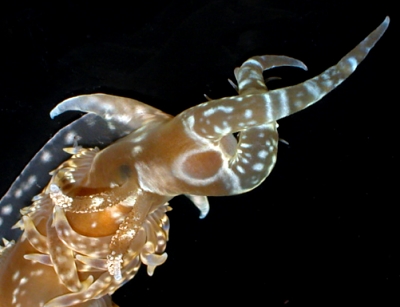Re: Anemone capture by Spurilla major
October 14, 2008
From: David Mullins


Concerning message #126:
Dear Bill,
Here are some photos of what we are calling Baeolidia major Eliot, 1903. Other synonyms are Spurilla major (Eliot, 1903) and Berghia major (Eliot, 1903). I guess I'll leave the latest definitive name to you guys.
Anyway, the pics illustrate the behaviour you made mention of on this forum as having observed with Spurilla australis. In this particular case the prey was not on an algal frond and could not drop away, however the base of the black photographic dish is very smooth affording little purchase for the 'pedal disc'. The long oral tentacles of the nudibranch however are certainly being put to the same use as you described in enveloping the prey.
Recently here at Woody Point I have observed up to 5 at a time of this species within an area of one metre square moving through the algae in strong tidal currents in the search for their anemone prey.
Locality: Woody Point, Redcliffe Peninsula, Moreton Bay, intertidal, Queensland, Australia., Pacific Ocean, 20 August 2008, Intertidal weed, rocky substrate. Length: 75 mm. Photographer: David Mullins.
Kind regards,
David Mullins
marineimages@hotmail.com

Dear David,
Thanks for these photos and the observations on its feeding behaviour. This seems to be a standard behaviour for some of these larger aeolids which eat sea anemones whole. It's good to get another observation.
Concerning the other names you mention for this species - they just demonstrate a lack of agreement in the genera of the Aeolidiidae. Some years ago when I was studying solar-powered aeolids and their close relatives, it became clear that in the soft-coral feeding species of Phyllodesmium, many of the anatomical differences resulted from adaptations they had evolved to 'farm' zooxanthellae in their bodies. In those times there were almost as many generic names used for species of Phyllodesmium as there were species (Rudman, 1981). Within the Aeolidiidae the genera Berghia, Baeolidia and Spurilla were very poorly defined and in a similar nomenclatural-taxomic mess. Some species had symbiotic zooxanthellae and branches of the digestive gland ramifying through all parts of the body wall and others did not, and yet all anatomists who have previously worked on these animals had ignored this fundamental fact. The only difference consistently argued was that the rhinophores were lamellate in Spurilla and papillate in Berghia. The question of Baeolidia was - and remains - even more confused because it was based on a single preserved specimen from the western Indian ocean which is unidentifiable. I proposed we use Spurilla for them all until the group was properly revised (Rudman, 1982), and I am sure the continued confusion will continue until they are properly revised. Since we can't define Baeolidia its use seems indefensible. I suspect a revision will suggest we need more than just Spurilla but until then the apparently random use of Spurilla, Berghia and Baeolidia is very confusing.
-
Rudman, W. B. (1981) The anatomy and biology of alcyonarian feeding aeolid opisthobranch molluscs and their development of symbiosis with zooxanthellae. Zoological Journal of the Linnean Society, 72: 219-262.
-
Rudman, W. B. (1982) The taxonomy and biology of further aeolidacean and arminacean nudibranch molluscs with symbiotic zooxanthellae. Zoological Journal of the Linnean Society, 74: 147-196.
Best wishes,
Bill Rudman
Related messages
-
Spurilla australis from Port Stephens
From: Leanne & David Atkinson, October 8, 2007 -
Spurilla australis from Lembeh Straits, Sulawesi
From: Matt Oldfield, March 26, 2007 -
Spurilla australis from Western
From: Bruce Potter, January 19, 2007 -
Spurilla australis from Victoria, Australia
From: Trevor McMurrich, August 22, 2006 -
Spurilla australis from Port Phillip Bay, Australia
From: Perry Davis, June 22, 2006 -
Spurilla australis from Northern New South Wales
From: Denis Riek, February 2, 2005 -
Spurilla australis from Western Australia
From: Mark Gerlach, February 20, 2004 -
Spurilla australis from Perth, Western Australia
From: Masoud Abadi, October 18, 2003 -
Nudibranch on Caulerpa taxifolia
From: Tim Glasby, August 18, 2003 -
Aeolidiopsis australis?
From: Nishina Masayoshi, August 6, 2002 -
Spurilla australis from Victoria
From: Jane Breidahl, January 9, 1999 -
Spurilla australis
From: Bill Rudman, July 2, 1998
